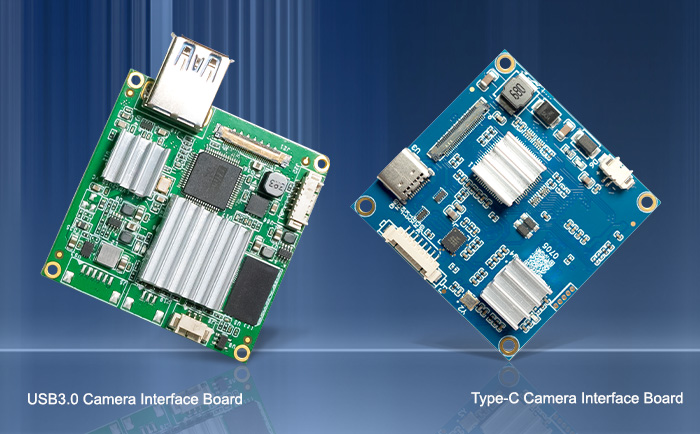Since its release in September this year, the LVDS to USB3.0 Video Capture Board(Type-c interface) has gained wide recognition in the market due to its high cost performance. Many industry sectors have expressed strong interest in it. However, there are also many users who worry: compared with the old USB3.0 interface board, will the performance be weakened under the high cost performance?

LVDS to USB3.0 Video Capture Board and USB3.0 Interface board
Unlike the USB3.0 coding acquisition module, the LVDS to USB3.0 Video Capture Board uses an integrated solution. Danny Wong, senior engineer of Xianyang Technology, will answer the question from the two directions of similarities and differences!
similarity
Docking camera: LVDS to USB3.0 Video Capture Board and USB3.0 Interface board can be connected to SONY FCB HD cameras and other LVDS interface HD cameras, with a wide range of applicability.
High-speed transmission: LVDS to USB3.0 Video Capture Board and USB3.0 Interface board are based on the USB3.0 standard development, the transmission rate of up to 5Gbps, enough to support the real-time transmission of high-definition video signals, to ensure that the picture is clear and smooth, but also to reduce the delay in the data transmission process, improve the user experience.
Platform compatibility: The two acquisition modules support a variety of operating systems and platforms, including Windows, Mac and Linux systems. The HD integrated camera module is directly connected to the USB interface of the PC through the acquisition module, and can realize real-time data transmission and control of the camera without additional drivers or configuration, greatly simplifying the installation and configuration process. This feature makes these modules more compatible and convenient in cross-platform applications, thus reducing the difficulty and cost of development.
Control function: Both can control the camera through the computer, TTL serial port, this control mode allows the module to send control instructions to the camera, such as adjusting the focal length, exposure, amplification, reduction, etc., so as to achieve remote control of the camera.
At the same time, it can also communicate with the external MCU, which can realize the relevant control of the camera and flexible interconnection with other devices, providing more powerful support for video acquisition and processing.
Brief summary
From the above similarities, LVDS to USB3.0 Video Capture Board and USB3.0 Interface board have a high degree of consistency in terms of applicability, transmission rate, control function, operating system compatibility and performance. These commonalities enable them to provide users with stable, reliable, efficient and convenient data acquisition and transmission solutions in practical applications.
difference
Cost performance: USB3.0 interface board, using the original imported chip, need to write their own software, FBGA image debugging. The LVDS to USB3.0 Video Capture Board uses a domestic chip, which has higher integration, the software has been written, and the image processing has been completed, and the user does not need to carry out additional programming and debugging work, and has a higher cost performance.
Interface type: This is the most significant difference. LVDS to USB3.0 Video Capture Board adopts USB3.0 Type-C interface, which has the characteristics of positive and negative blind insertion, that is, it can be inserted without distinguishing the interface direction, which improves the convenience of use. The USB3.0 interface board usually uses the traditional USB3.0 Type-A interface and needs to be inserted in the correct direction.

Power supply voltage: The USB3.0 interface board can use USB3.0 cables to directly power the camera, and the voltage is 5V, reducing the number of cables. One cable solves all problems (for example, when the USB3.0 cable is insufficient and the camera cannot be started, external DC 12V power supply is required).
The LVDS to USB3.0 Video Capture Board must use a separate DC 12V power supply to power the camera, which is more advantageous in some application scenarios that require higher power supply.
Appearance size: In the case of excluding the interface and the heat sink, the size of the LVDS to USB3.0 Video Capture Board and the USB3.0 interface board are 48x48x5mm, if the interface and the heat sink are included, the design characteristics of the former Type-C interface have a smaller size of 48x48x9.5mm. This is an important advantage for applications where space is limited. The 58x48x10.5mm size of the USB3.0 interface board may take up more space due to the larger interface size.
Operating temperature: Due to the use of domestic chips, LVDS to USB3.0 Video Capture Board can only work normally in the environment of -5 ° C to +60 ° C, compared with USB3.0 interface board of -40 ° C to +75 ° C, the former has relatively greater limitations in the use of the environment.
In SUMMARY:
To sum up, LVDS to USB3.0 Video Capture Board and USB3.0 interface board are the same in terms of docking cameras, high-speed transmission, platform compatibility and control functions, but there are obvious differences in cost performance, interface Type, electromagnetic compatibility, power supply voltage, appearance size and operating temperature. In the selection, the user should choose the appropriate code acquisition module according to the specific application requirements and scenarios.
 Sony FCB camera block
Sony FCB camera block